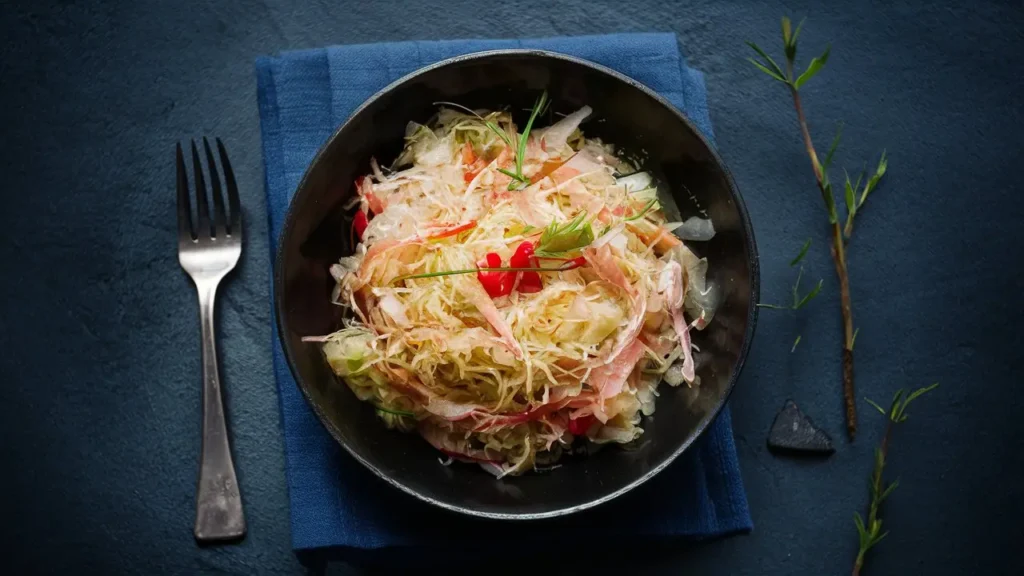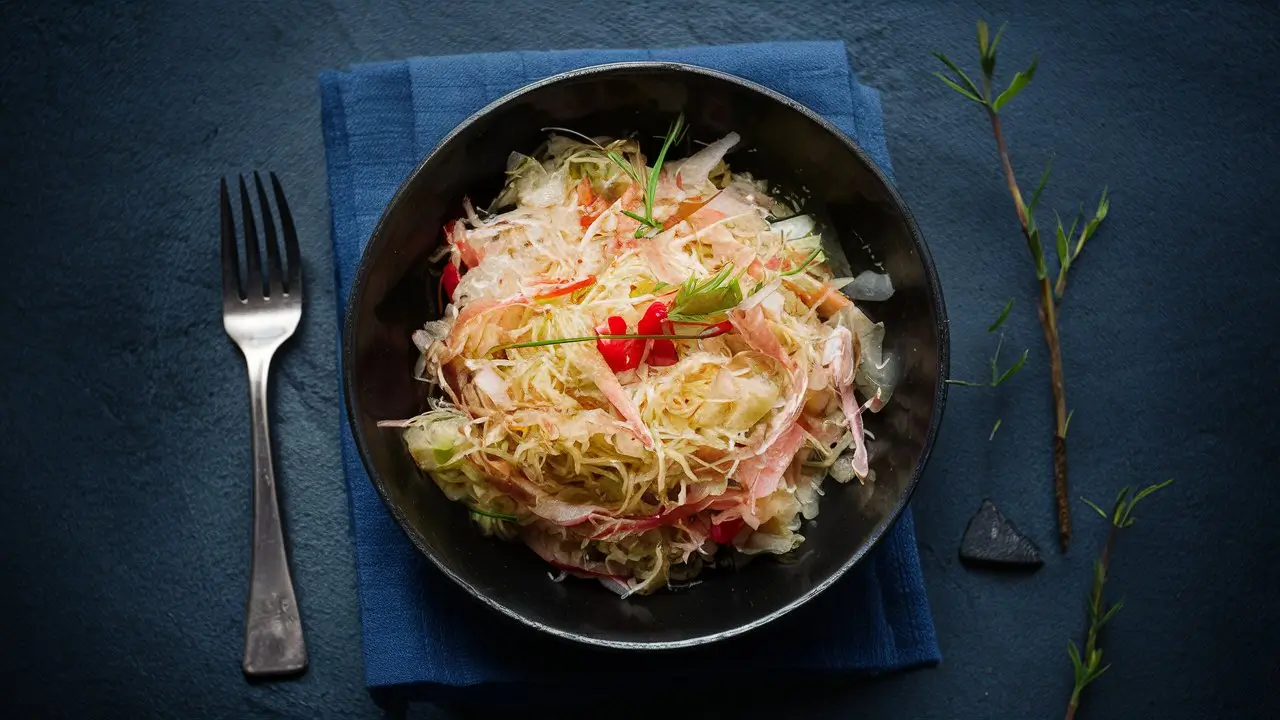If you’re a fan of exploring new culinary traditions, the German Kitchen Ritual recipes are a must-try. These recipes showcase the unique culinary traditions of Germany and will fascinate your taste buds. From tangy Sauerkraut to succulent sausages, each ingredient plays a vital role in creating the authentic taste of these dishes.
In this article, we’ll guide you through the fascinating world of German Kitchen Ritual Recipes, from traditional techniques to the cultural significance behind each dish. Get ready to create mouthwatering recipes in your own kitchen!

Some Traditional German Kitchen Ritual Recipes
Here are some traditional German recipes that are often associated with kitchen rituals:
1- Sauerkraut and Sausages: This is a classic German dish that combines fermented cabbage (Sauerkraut) with various types of sausages, often served with potatoes or bread.
2- Schnitzel: Breaded and fried meat, typically made with pork or veal, served with a side of potatoes or a fresh salad.
3- Sauerbraten: A pot roast marinated in vinegar, water, and spices, then slow-cooked until tender. It is often served with potato dumplings or spaetzle.
4- Pretzels: Traditional German pretzels are soft, chewy, and twisted bread snacks, often enjoyed with mustard or as a side to soups and sausages.
5- Black Forest Cake: A rich and indulgent chocolate cake layered with cherries and whipped cream, often decorated with chocolate shavings. These recipes are just a few examples of the many traditional German dishes that can be part of kitchen rituals, showcasing Germany’s unique flavors and culinary heritage.
How are German kitchen ritual Recipes different from other culinary traditions?
German kitchen rituals differ from other culinary traditions in a few ways.
1st- German kitchen rituals often involve specific techniques and ingredients unique to German cuisine. These rituals have been passed down through generations, preserving the traditional flavors and cooking methods.
2nd- German kitchen rituals have cultural significance. They are about preparing a meal, celebrating German heritage, and creating a sense of community. These rituals are often associated with special occasions or holidays, adding a deeper meaning to cooking.
3rd- German kitchen rituals emphasize attention to detail and precision. From precise measurements to specific cooking times, these rituals showcase the German commitment to quality and craftsmanship in the kitchen.
Overall, German kitchen rituals offer a distinct and cherished culinary experience, combining tradition, cultural significance, and a focus on excellence in cooking.
How to Make German Kitchen Ritual Recipe (Sauerkraut)
I’m going to tell you about a German Kitchen Ritual Recipe that is called Sauerkraut. Before making it, You need this Equipment and ingredients.
Equipment:
- Large fermentation crock or glass jar with an airtight lid
- Cabbage shredder or sharp knife
- Mixing bowl
- Weight or fermentation stone
- Clean cloth or cheesecloth
- Rubber band or string
Ingredients:
- 5 pounds (2.3 kg) Fresh cabbage (preferably green or white cabbage)
- Salt (preferably non-iodized, such as sea salt or kosher salt)
- Optional: Caraway seeds, juniper berries, or other spices for flavoring.
Step-by-Step Instructions
Step 1- Start by gathering the ingredients: You will need fresh cabbage and salt.
Step 2- Remove the outer leaves of the cabbage and set them aside.
Step 3- Shred the cabbage finely using a knife or a cabbage shredder.
Step 4- Add the shredded cabbage in a large mixing bowl and sprinkle it with salt. Use your hands to massage and squeeze the cabbage to release its natural juices.
Stetp 5- Transfer the cabbage and its juices into a clean fermentation crock or glass jar. Pack it down tightly, ensuring there are no air pockets.
Step 6- Place the reserved cabbage leaves on top of the packed cabbage to create a barrier.
Step 7- Place a weight or fermentation stone on top of the cabbage to keep it submerged in its brine.
Step 8- Cover the crock or jar with a clean cloth or cheesecloth and secure it with a rubber band or string.
Step 9- Store the Sauerkraut in a cool, dark place for about 1 to 4 weeks, depending on your desired level of fermentation.
Step 10- Check the Sauerkraut periodically, skimming off any scum that may form on the surface. Taste it to determine if it has reached your desired level of tanginess.
Step 11- Once the Sauerkraut is ready, remove the weight and the cabbage leaves. Transfer it to clean, airtight jars or containers and store it in the refrigerator.
Step 12- Enjoy your homemade Sauerkraut as a flavorful condiment, side dish, or ingredient in various recipes. It will continue to develop flavor over time.
Tips for Making German Kitchen Ritual Recipe(Sauerkraut) Better
1- Choose fresh cabbage: Select fresh, firm heads of cabbage for the best results. Look for cabbage that feels heavy for its size and has crisp leaves.
2- Shred the cabbage finely: Use a cabbage shredder or a sharp knife to shred the cabbage into thin, uniform strips. Finely shredded cabbage ferments more evenly and results in a better texture.
3- Massage the cabbage with salt: Sprinkle the shredded cabbage with salt and use your hands to massage it thoroughly. This helps to break down the cell walls, release the cabbage’s natural juices, and create a brine for fermentation.
4- Pack the cabbage tightly: Transfer the salted cabbage into your fermentation vessel, packing it down tightly with your hands or a wooden spoon. This helps eliminate air pockets and ensures the cabbage is fully submerged in its brine.
5- Use a weight or fermentation stone: Place a weight or fermentation stone on top of the cabbage to keep it submerged under the brine. This helps to prevent mold growth and ensures a successful fermentation process.
6- Cover with a clean cloth: Cover the fermentation vessel with a clean cloth or cheesecloth to allow airflow while keeping out dust and insects. Secure it with a rubber band or string.
7- Ferment in a cool, dark place: Find a cool spot in your home, away from direct sunlight, to ferment the Sauerkraut. Ideal temperatures range from 60°F to 75°F (15°C to 24°C).
8- Check and taste regularly: During the fermentation process, check the Sauerkraut regularly to ensure it remains submerged and to skim off any surface scum. Taste it periodically to gauge the level of tanginess you prefer.
9- Fermentation time: Fermentation typically takes 1 to 4 weeks, depending on your desired level of sourness. Start tasting after a week and continue until it reaches your preferred flavor.
10- Store in the refrigerator: Once the Sauerkraut has reached your desired taste, transfer it to clean, airtight jars or containers and store it in the fridge to slow down the fermentation process.
How to Store German Kitchen Ritual Recipe(Sauerkraut)
1- Transfer to a clean, airtight container: Once your Sauerkraut has reached the desired level of fermentation, transfer it to clean, sterilized jars or airtight containers. Make sure the containers have a tight seal to prevent air from entering.
2- Press down and remove air bubbles: Press down on the Sauerkraut to remove any air bubbles that may have formed during the transfer. This helps to ensure that the Sauerkraut is fully submerged in its brine.
3- Add a layer of brine (optional): If the brine level has decreased during fermentation, you can top off the Sauerkraut with additional brine made by dissolving 1 teaspoon of salt in 1 cup of water. This helps to maintain the proper acidity and prevent spoilage.
4- Seal and refrigerate: Seal the containers tightly and place them in the refrigerator. The cool temperature of the fridge slows down the fermentation process and helps to preserve the Sauerkraut’s flavor and texture.
5- Use within a few months: Sauerkraut stored in the refrigerator can typically be enjoyed for several months. However, consuming it within 6 months is recommended for the best quality and flavor.
Nutritional Fact
Amount Per Serving
- Calories: 30
- Iron: 14% of the Daily Value
- Carbs: 7 grams
- Potassium: 6% of the Daily Value
- Protein: 1.5 gram
- Sodium: 42% of the Daily Value
- Fiber: 5 grams
- Manganese: 10% of the Daily Value
- Folate: 10% of the Daily Value
- Copper: 16% of the Daily Value
- Vitamin C: 24% of the Daily Value
- Vitamin K1: 15% of the Daily ValueV
- Vitamin B6: 11.5% of the Daily Value
Conclusion
The German Kitchen Ritual Recipe represents a cherished culinary tradition that showcases German cuisine’s unique flavors and techniques. With attention to detail, cultural significance, and emphasis on quality, this ritual offers a delightful experience for home cooks, food enthusiasts, and anyone seeking to explore the rich heritage of German cooking. Whether it’s Sauerkraut, schnitzel, or other traditional dishes, embracing the German Kitchen Ritual Recipe allows us to savor the flavors and create lasting memories in the kitchen.
